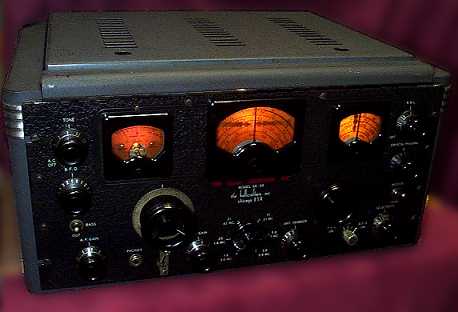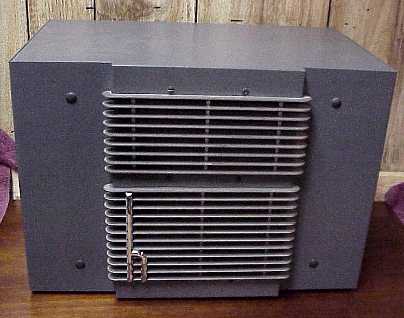Hallicrafters SX-28
From the August 1940 introductory ad in Radio News:
"The new 1941 SUPER SKYRIDER.
A few fundamentals of the new Super Skyrider are 6 bands covering 540kc to 43 mc - 2 stages of preselection - high fidelity, push-pull audio - band pass audio filter - a new and highly efficient crystal filter circuit - an additional and completely effective noise limiter - cadmium plated steel chassis - standard relay rack panel 1/8 inch thick - machine tool, gray wrinkle, well ventilated steel cabinet. Hallicrafters-Jensen Bass Reflex speakers available. Sells, complete with crystal and 14 tubes, less only speaker, for $159.50 net."
(Later ads corrected the tube count to 15.)
Hallicrafters SX-28

Super Skyrider logo

The SX-28 is arguably Hallicrafters' finest pre-war set (short of the specialty-market dual diversity DD-1). It is a very well designed and engineered single conversion Broadcast and HF receiver. It uses push-pull 6V6 audio output tubes and is known for excellent sound on AM broadcast. It was often advertised with a large matching Hallicrafters-logo floor-model Jensen speaker. The PM-23 speaker is also a match for the SX-28. Many of these radios saw service during the War. The SX-28 and its sister VHF models, the S-27 and S-36 were rack-mounted in British government listening posts for monitoring German radar and communications. The Radio Intelligence Divison (RID) of the FCC and the Foreign Broadcast Intelligence Service (FBIS ) also used these during the War to monitor the airwaves for American intelligence agencies. Radio News has an article covering the Radio Intelligence Divison in the October 1944 issue. The SX-28 is prominently displayed in both mobile and fixed listening posts. The typical fixed listening post had six SX-28 receivers and one S-27. The FBIS is covered in the January 1945 issue. That article includes a picture of a wall with twenty rack-mounted SX-28 receivers. After the War, the SX-28/28A continued to be used by the FCC to monitor domestic radio transmitters. The September 1946 issue of Radio News, page 92, shows a picture of one installed in an automobile equipped for monitoring by the FCC.
The SX-28A is a very similar receiver. Some earlier SX-28A receivers are labeled as SX-28. Check the serial number for proper identification. The major electronic difference between the two versions is the placement, style, and servicability of the coils and trimmers around the bandswitch. This will be obvious to anyone attempting alignment. One cannot use the pictorial location of the coils for one model when aligning the other.
A later version of the SX-28A is also distinctive, using a 6AB7 instead of a 6SK7 as the second RF amp. Details of that variation are in the 16th Rider volume. Both the SX-28 and the earlier SX-28A version also use the 6AB7 for first RF and Lamb noise silencer amplifier. However the earliest SX-28 uses the 6SK7 for all of these functions. The 6AB7 is not just a plug-in replacement as the higher screen voltage requires a change in circuit. A number of other variations in the SX-28 and SX-28A exist such as the location and placement of the fuse holder and the existence and orientation of the standby socket (horizontal on some, vertical on others, missing on others). It would be interesting to track some of the variations within the SX-28/28A family relative to serial numbers and years of manufacture.
The PM-23 speaker is a match for the SX-28 as well as the Hallicrafters SX-23, 24, and 25. Many PM-23 speakers were made without the stylized bright chrome "h" on the lower left side of the grille. Whether the elimination of the "h" was a cost-saving measure or a war-related saving of chromium, I do not know.

In the illustration below of Bill Halligan, (President of and the "Halli" in Hallicrafters) the speaker has the "h" on the right. Note which radio Halligan displays. The painting is from a 1944 ad placed by Electronic Labs.
